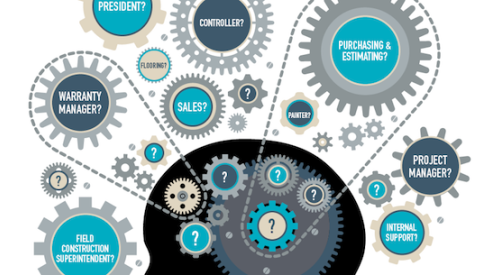A strange and sadly touching thing happened today. Our two family pets died within eight hours of each other, both of old age and natural causes.
 |
Lex and Jenny didn't come off as best pals, and I don't have any heartwarming, anthropomorphic stories about how they worked out their differences with the help of a friend over a can of tuna. Yet these natural enemies were in the same house 24 hours a day for more than 12 years and were never once kenneled. Imagine that, being with someone virtually every minute of your life. Over those 12 years they developed a relationship that was subtle but very supportive. I can't recall one instance of a hiss or a growl between them after their first month together. Many times I caught Jenny up on Lex's elevated dog bowl stand, stealing bits of his food while he ate. He, likewise, would invade her food and water domain in the basement, and she didn't seem to mind.
As I sat looking at them lying side by side where I had placed them on the cold floor of our pump house, I mentally calculated the statistical odds they would both die on the same day. If you take a two-year period either side of an average life expectancy for such animals, it comes out to more than one in two million! You may think its coincidence, but my family can only conclude that they were far more tied together emotionally than we could have imagined. Their relationship ran deep.
If you have been reading my columns over the past eight years, you know what comes next, but I can't blame you if you are wondering, "Now how is Sedam going to tie THIS story to home building?" It is surprisingly easy, because I am just wrapping up the most intense two-month period of work in my entire life — weeks on end of 7 a.m. to 10 p.m. weekdays plus Saturday mornings, Sunday afternoons and evenings.
It has taken that level of attention to pull off a conference that we are holding next week called Alliance — TrueNorth's Executive Conference. Reaching our goal became doubtful due to a combination of the recently-hammered home-building economy, deciding too late to go ahead with plans and being new to the conference game. Yet we have done it, people have responded and I know why. It is because of the message. The singular focus of Alliance is building productive, high-performance relationships among builders, suppliers and trade contractors. It's a message whose time has finally come, and strange as it may seem, the passing of Lex and Jenny gave me some insight on that.
When I began concentrating exclusively on the building industry in the late 80s, the first and most obvious missing factor was a focus on customers. If there is one thing that has truly changed for the better, it is that, by and large, the industry has finally "gotten it." Many builders are still not executing well, but we have accepted that creating customer delight through a total customer experience is not just the right thing to do; it is good business and it pays.
That took most of the 90s. Since then, we have made significant strides in the next most obvious factor, which is a commitment to our employees. The best builders are beginning to value and thus manage their employee resources as much as they do land, inventory or money. We have a long way to go, but there are now solid models out there: builders who point the way for the rest of the industry.
Yet, as I have said many times over the years, ultimately you cannot treat your customers better than you treat your own people, and that includes your suppliers and trades. This is not just a common sense notion any more. We have data that correlates high customer satisfaction with high supplier/trade satisfaction. Few builders though — even most of the more progressive ones — seem to understand this. When I make these statements, I always get support. Yet when I look for specific evidence and behaviors that demonstrate how a builder is proactively building long-term positive relationships with suppliers and trades, I see very little genuine substance. Just because you have a trade appreciation breakfast and pass out T-shirts now and then doesn't mean you have what it takes.
In these days of tightening markets and shrinking overheads, the builder/supplier/trade relationship is more critical than ever. As I detailed in my April column, (see "Your Choice in Cost Control") there is 10 times as much money in house costs as in overhead. Add in land development's price and it's 12–15 times more. That is where the real money is, and the quality of the supplier and trade relationships determines how well you can get at it in a way that still allows the highest levels of customer satisfaction. As far as the most powerful tools for cost reduction go — even-flow, Six Sigma and lean manufacturing techniques — without the very strongest relationships, don't even think about it working.
It's a troubling notion for many, but we have to face the fact that, presuming you know how to manage land and finance, relationships are the single greatest key to success in this business. What we so often assume are naturally adversarial, competitive relationships don't have to be. The old models of "hammer the trades" and playing one supplier off against the other are counterproductive. There is a new paradigm of high-level cooperation, and though rarely practiced, it works.
This doesn't mean we have to always be best friends, but mutual respect and trust are the non-negotiable building blocks of any productive relationship. Now challenge yourself: do your relationships with your suppliers and trades stand up to that test? How about your non-construction suppliers, such as marketing consultants, attorneys and bankers? How about your relationships with the communities in which you build? If you are going to manage effectively through the downturn and beyond, you need these relationships to be the strongest they can be, and for most of us, this requires a change of paradigms.
I can't say that Lex and Jenny were what we'd call best friends. But they found themselves in close proximity and forged a relationship of mutual trust, respect and support in order to please the customer — our family. They knew innately that whatever natural differences they were born with were subordinate to their critical needs of food, shelter, protection and love. We should be so smart. Some of you are, because I've been seeing it out there; there is a genuine movement of builders, suppliers, trades manufacturers and distributors trying to come together and build their relationships on a different level. More than 200 of them have decided to travel to the glamour spot of the nation, Detroit, in a difficult year to work on just that at the Alliance conference. But it doesn't take participation in a conference to help push this movement forward at the local level. It just takes you and a handful of your best suppliers and tradespeople to make the choice and change your world.
I have to go dig a grave now, a big one. I could just drop Lex and Jenny off at the vet, but the kids would never forgive me. Besides, there is this beautiful spot across the meadow along the tree line where the rabbits and squirrels run. Lex and Jenny lived great lives together and I see now that they were smarter than I ever realized. I hope all of us can live as well and be as smart.
| Author Information |
| Scott Sedam is President of TrueNorth Development, a nation-wide consulting & training firm focused on quality, process improvement and organizational development. He can be reached at scott@truen.com |












